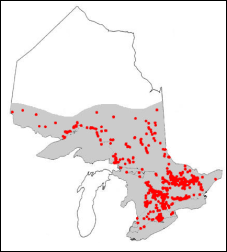Brown Trout (Inland)
Information about the Inland Brown Trout (Salmo trutta), a cold-water fish which has been introduced to Ontario.

What it looks like
- Back is brown; sides pale brown or silvery; belly is white
- Large black, blue or red spots on body, often surrounded by lighter ring
- Tail with few spots
- The only salmon or trout with orange on adipose fin
- Leading anal fin ray extends the length of the fin
- Short, stocky caudal peduncle
Size
- length: 35-60 centimetres (14-24 inches)
- weight: 0.45–1.36 kilograms (1-3 pounds)
- Ontario record: 15.6 kilograms (34.4 pounds)
Similar fish
Where it is found

Range
- introduced into Ontario streams from Europe in 1913
- now found throughout the Great Lakes and their tributaries, and streams in southern Ontario
- most abundant in Lake Ontario, Georgian Bay, Great Lakes tributaries, inland stocked creeks
- use Fish ON-Line, an interactive mapping tool, to find specific lakes and rivers
Habitat
- pools or ponds fed by streams
- quiet, calm waters
- turbulent, fast-flowing streams
Angling Tips
- feed most aggressively at night
- cast from piers and break-walls
- use brook trout bait to catch the inland lakes variety
- target the Great Lakes variety by trolling
- look for the Great Lakes variety in shallower waters than rainbow trout and Chinook salmon
- in the fall, catch the Great Lakes variety in tributaries using small spinners or plugs, or small baits beneath floats
Common Baits
- spinners, spoons, jigs
- small plugs, including those imitating minnows
- flies, worms, roe
Photos/images
Illustration Credit: Wisconsin Department of Natural Resources
Map credit - modified from: Mandrak and Crossman (1992)
Updated: December 15, 2025
Published: July 18, 2014